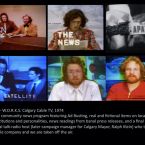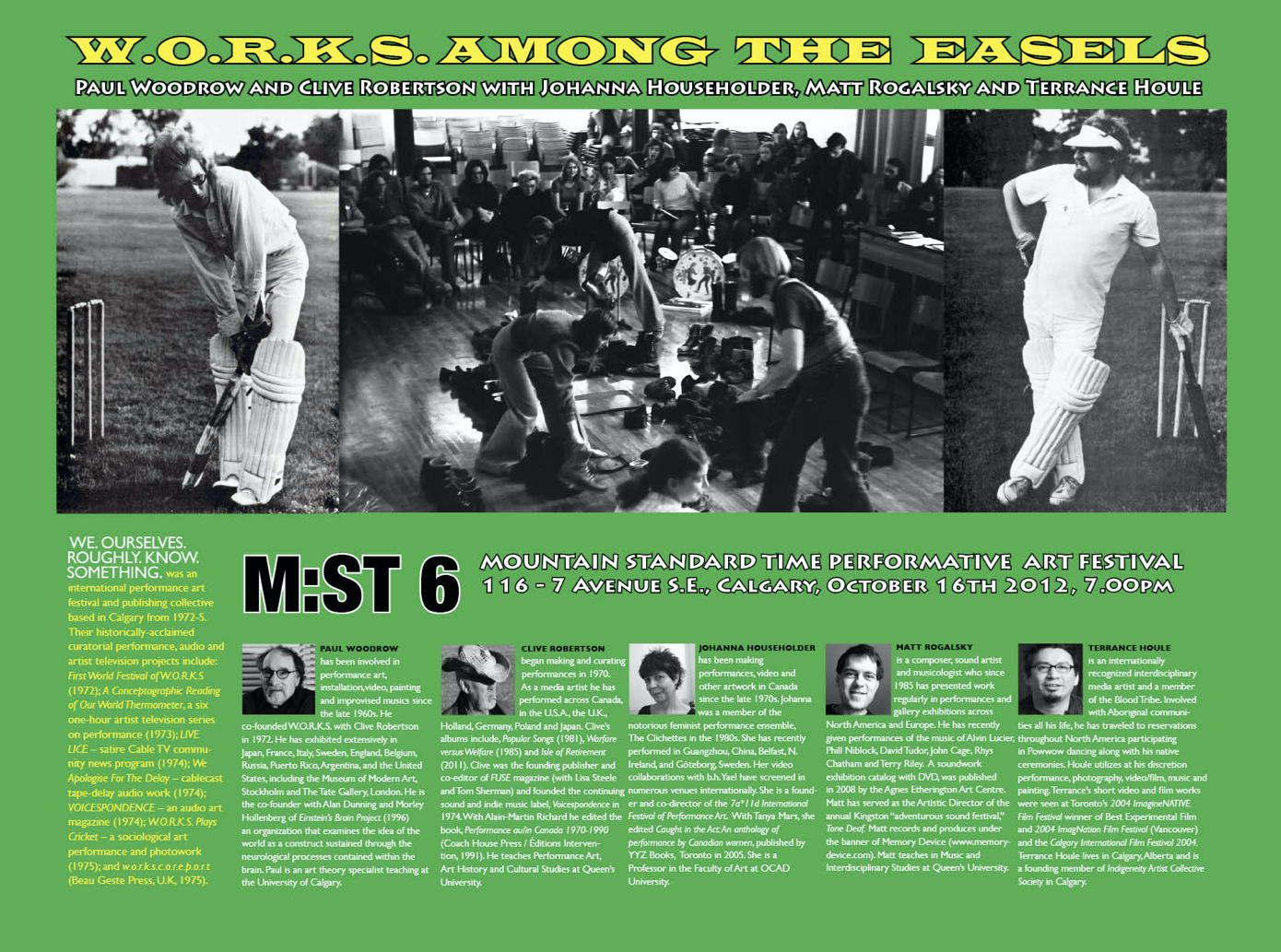Published in 1975, w.o.r.k.s.c.o.r.e.p.o.r.t.. documents the individual and collaborative actions and curated projects of artists Clive Robertson and Paul Woodrow presented in loose chronological order between 1970 and 1974. The book has two introductions, an index, a group biography, concert programmes, and a list of print and video publications.
Robertson and Woodrow met in March 1972 in Calgary and formed the performance and publishing collective, W.O.R.K.S. (We.Ourselves.Roughly.Know.Something.) with participation from Su Clancy (Robertson), Rick Holyoke, Judith Woodrow, David Smith, Ken Jones, and Bill Rowat. From its inception, W.O.R.K.S. took an internationalist approach through its organization of invitational performance and video projects, and by becoming a “foreign contact centre” for the International Artists’ Cooperation (I.A.C.) [1]. In 1973, the action poet and Fluxus artist Robert Filliou dedicated his performance, Telepathic Music No.2 to “the Canadian members of the Eternal Network: Véhicule, Montréal; General Idea, Toronto; W.O.R.K.S., Calgary; and Image Bank, Vancouver” [2].
w.o.r.k.s.c.o.r.e.p.o.r.t. was printed by the highly productive independent publishing venture Beau Geste Press (1971-1976), in an edition of 500 copies with 300 distributed by BGP and 200 by W.O.R.K.S. itself. Edited by Robertson and Woodrow and assembled by the collective, the publication’s title graphically underlines “s.c.o.r.e.” to emphasize its investments in Fluxus-influenced event scores and other observational/instructional methods common to experimental musics, happenings, and various forms of artist documentation. As such, the activities of W.O.R.K.S. are recognizable in George Brecht’s definition of Fluxus: “Individuals with something unnameable in common have naturally coalesced to publish and perform their work” [3].
Of germinal importance to BGP’s publication of w.o.r.k.s.c.o.r.e.p.o.r.t.. was the relationship of W.O.R.K.S. via international networking with David Mayor, a co-founder of the press with the Mexican anarcho-syndicalist artist Felipe Ehrenberg and Mart(h)a Hellion. Ehrenberg fled Mexico fearing persecution for his participation in ’68 protests and sought exile with Mart(h)a and their two children in England. Rapidly involved in a London art scene, Ehrenberg met Mayor and was invited by him to Exeter, which spurred his relocation to the countryside and the establishment of BGP at “Langford Court, the beautiful, thatched mansion that had sat, overlooking the tiny hamlet of Clyst Hydon near Cullompton, since the 14th Century” [4]. The name Beau Geste Press originated as a playful riff on “gesture” as action and “Gestetner” as BGP’s primary printing machine.
BGP’s interests in artist documentation is well-represented in the FLUXSHOE festival, in which W.O.R.K.S. participated, primarily organized by Mayor from October 1972 to October 1973. As an art history doctoral candidate, Mayor created FLUXSHOE, a touring festival described as “a small travelling show, with the intention of exhibiting the published work of many artists, non-artists, and an-artists who have published or performed with Fluxus” [5]. The FLUXSHOE festival toured seven cities in the UK (intentionally avoiding central London) in a second-hand van transporting an assembly of works that were displayed “in a modular system of cardboard cubes” [6], while also presenting live performances at venues along the way. In 1973 Woodrow performed in Croyden, Nottingham, and Blackburn; Robertson and Clancy performed in Hastings [7].
In preparation for the festival, BGP had 2000 copies of the FLUXSHOE catalogue commercially printed with contributions collected via correspondence from most festival participants, including members of the Fluxus establishment (like George Maciunas, Yoko Ono, Joseph Beuys, Takehisa Kosugi, Ben Vautier, Takako Saito and others). Additionally, BGP produced a series of unique broadsheets by the participating artists at each venue, which became the compilation Fluxshoe Add End A 72-73 (1973). Among the many artists in these addenda, one finds contributions by COUM Transmissions (pre-Throbbing Gristle), Helen Chadwick, Woodrow, Robertson, and Clancy. Like the important Fluxus imprint Something Else Press (1966-74) led by artist and publisher Dick Higgins, Beau Geste’s scrappier Gestetner and letterpress publications included books by artists, event documentation, and a series of art reportage titled Schmuck focussing on specific national art scenes under the guidance of individual artists: France (Robert Filliou), Iceland (Kristján Gudmundsson), Czechoslovakia (Milan Knížák), Japan (Takehisa Kosugi), Hungary (Endre Tót), and Germany (Wolf Vostell).
w.o.r.k.s.c.o.r.e.p.o.r.t. exists firmly within this rubric of event-based and self-directed artist documentation. Robertson and Woodrow’s individual performances and the collaborative para-institutional activities of W.O.R.K.S.—including artist archives, audio recordings, video production, performance events, festival organization, and television interventions—are recorded through photographs, performance ephemera, and indexical detail. The publication provides rich evidence of the activities of W.O.R.K.S, which serves as a demonstration of its significance in both Canadian and international art contexts. As a performance survey text, w.o.r.k.s.c.o.r.e.p.o.r.t. is one of the form’s earliest examples in Canada, predating important collections such as: Performance By Artists (1979) edited by Peggy Gale; Performance, Text(e) & Documents (1980) edited by Chantal Pontbriand; Performance au/in Canada 1970-1990 (1991) edited by Alain-Martin Richard and Clive Robertson; Live at the End of the Century (2000) edited by Brice Canyon; Art Action 1958-1998 (2001) edited by Richard Martel; Caught In The Act: An Anthology of Performance Art by Canadian Women (2004) and More Caught In The Act (2016), both titles edited by Johanna Householder and Tanya Mars.


Following the projects documented in w.o.r.k.s.c.o.r.e.p.o.r.t., W.O.R.K.S. continued with the 1974 production of the audio art cassette magazine, Voicespondence, which features Image Bank, General Idea, Dick Higgins, Robert Filliou, Suzy Lake, Emmett Williams, Cosy Fanni Tutti, John Oswald, David Mayor and more. Led by Rick Holyoke, W.O.R.K.S. produced a TV satire, Live Lice for Cable TV and, in 1975, Woodrow and Robertson produced W.O.R.K.S. Plays Cricket, a photo and performance critique of art as occupation. In 2012, there is a re-performance of “W.O.R.K.S. Amongst The Easels” (1973) organized by the Calgary festival, M:ST (Mountain Standard Time). For this final anniversary event, Woodrow and Robertson were joined by invited artist performers Terrance Houle, Johanna Householder, and Matt Rogalsky. Sadly, in 2015, Woodrow passes away.
Beyond W.O.R.K.S., Woodrow collaborated with Brian Dyson (Syntax Arts Society); art sociologist, Hervé Fisher; feminist artist Mireille Peron (Anecdotal Waters/Anecdotes d’eau); and Alan Dunning on the Einstein Brain Project (1995-2001). For Robertson, the promise of W.O.R.K.S. as a collaboration and critique continued in 1975-8 with Robertson’s work at the Parachute Center of Cultural Affairs/Artons instigating artists residencies, video publications and festivals. Working in Calgary with Marcella Bienvenue and in Toronto with Lisa Steele, Tom Sherman, Kim Tomczak, Carole Conde, Karl Beveridge, John Greyson, Otis Richmond (and many others) publishing continued through the magazine Centerfold/FUSE (1976-2014). Collaborating with Janet Martin, Voicespondence (the audio art magazine) becomes an alternative music label producing vinyl releases by The Government, Gayap Rhythm Drummers, De Dub Poets, Fifth Column, the Plasterscene Replicas, and Clive Robertson. While based in Toronto, Ottawa, Montréal and Kingston, further performances and pedagogies are shared with Frances Leeming.
Through these multifaceted histories, W.O.R.K.S. contributes to the aesthetic and political practices that defined Canada’s artist peer-to-peer networks of the 1970s and, as artist-run centres grew, to become an essential platform of cultural production into the present. As a publication, w.o.r.k.s.c.o.r.e.p.o.r.t. stands as a rediscovered treasure that documents the vibrancy of decentralized artistic production with a mandate that was informed by international art activities and serious interests in a spirited Canadian cultural revolution.
Craig Leonard





